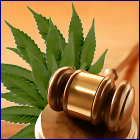In medicamento est veritas [ENG]
Let’s talk about drugs.
Definition

First of all, what is a drug? From a scientific point of view a drug is just an active substance which, when taken, alters the state of consciousness of an individual and his/her perception of reality. In practice, drugs act on neurotransmitters, stimulating or inhibiting more or less intensely their production, or acting directly on the neuromolecule itself. In a larger sense, we can call drug any substance that contains one or more of these active principles.
If we carefully analyze this definition, we can clearly see how it is also applicable to a wide range of substances we call medicines. In fact the distinction between a medicine and a drug is related only to the usage that we make of that substance. In practice we talk of medicine when the aim is to restore some function, returning a body altered by a disease to normality, while we use the term drug when its consumption is intended to induce dysfunction in a generally healthy body. In general, both the former and the latter meaning can be often applied to the same chemical. However, be careful not to get confused: generally medicines are substances that operate on organic dysfunctions, that is physical ones, while drugs act primarily on mental functions. The exception is represented by those drugs that we call psychotropic medicines.
Now, if we take as a reference the second definition, that is, if we consider drugs those substances that, containing certain active principles, produce specific dysfunctions in an otherwise healthy body, then substances such as opium, cocaine, marijuana, hashish, LSD, ecstasy, peyote, hallucinogenic mushrooms, mescaline, heroin, morphine, crack, methadone, and amphetamines as well as psychotropic drugs, including antidepressants and sleeping pills, alcohol, tobacco, coffee and even tea and chocolate, to name a few, all fall within that definition. Certain active principles are present in small amounts even in milk, bananas, pepper, nutmeg, and the chili pepper.
Classification of drugs
It is of course possible to classify drugs according to their chemical composition, however, from a social perspective, it is more important to analyze them on the basis of other parameters. Let me state that from this point of view there is no universally accepted criteria to classify the danger of these substances. What is written in this article is therefore a personal and questionable analysis of how to classify these substances from a merely social perspective.
Let us consider four parameters: the intensity of the effect, the tolerance to consumption, the induced degree of dependence, and the damage caused the body.
The intensity of the effect

The intensity of the effect of a drug depends on many parameters and varies over time even if the dose is the same. Furthermore, the consumption of several active principles at the same time may alter the effect of a specific drug. Ultimately it is not possible to predict in advance such a value depending only on the dosage.
In general, if we classify drugs according to the effect, we can identify three possible categories of symptoms: narcotics, stimulants, and hallucinogens. Among the narcotics are sedatives such as barbiturates, opiates, and anesthetics. Among the stimulants are natural substances such as caffeine and theine, or synthetic drugs such as ecstasy. Among the hallucinogens, we have the lysergic acid diethylamide-25, better known as LSD, marijuana and some methamphetamine. The various categories are not complementary, however. Ecstasy, for example, has both stimulating and hallucinogenic effects.
The tolerance to consumption
Tolerance is the ability of an organism to withstand the consequences of the consumption of an active principle. This tolerance, besides being dependent on the drug and the body itself, depends also on the method and frequency of consumption. For example, in ancient times many powerful figures acquired a certain tolerance to some types of poison assuming small doses of it on a frequent basis.
More properly we use the term desensitization if the tolerance increases with consumption, sensitization (or reverse tolerance), if it decreases. Just to give a concrete example, derivatives of Cannabis produce sensitization, that is, the same effect can be achieved over time with smaller and smaller doses, as opposed to what happens with LSD or heroin.
The degree of dependence
The dependence on a drug (addiction) measures the difficulty that an individual has to do without a specific active principle and therefore it can relate to the physical sphere, to the psychic sphere, or to both of them. In case we consider just the psychical aspect, this is materialized in the form of an obsessive desire of the consumption of the substance in question, while taking in account the physical one, we have a real need of consumption which, if not satisfied, may take to the abstinence syndrome, a state characterized by mental and physical states of agitation, irritability, irregular changes in body temperature, severe sweating, various types of disorders such as cardiovascular and respiratory ones, dysmetria in movements, convulsions, hyperesthesia and various forms of hallucinations, both visual and auditory.
Some drugs, such as marijuana, give substantially no physical dependence, and generate a psychological dependence by far less than that, for example, produced by nicotine. Others, however, can take to a strong physical dependence after only few doses and therefore, in case of lack of consumption, they cause abstinence crises.
The damage to the body

Each active principle, in addition to specific effects on consciousness and perception of reality, can have one or more side effects on the body, generally harmful. Describing all of them would require a booklet of several tens of pages for each substance, because in fact each molecule produces different consequences, at time temporary, at other time reversible, and on other occasions permanent too.
For example, opioids, in excess, can lead to serious complications of the cardiovascular and respiratory systems, often with fatal consequences, but in fact are not toxic at the cellular level and so their use does not involve permanent damage, which is in contrast the case of alcohol, which can seriously damage the internal organs, most notably the liver. The ethanol is in fact one of the hardest drugs both in terms of dependence and physiological damages.
Social consequences
In addition to the consequences that we have seen and which relate to the individual, drug-taking has two social effects that affect our society: the damage that individuals may cause to others when they are under the influence of these substances, and the costs of detoxification for those drugs that involve addiction.
An example of the first consequence are the car accidents caused by the consumption of spirits or other drugs such as ecstasy or cocaine. In general, narcotics and hallucinogens make really dangerous any activity, even those that requires small concentration such as simply taking a dip in the pool, while stimulants can impact disinhibitors which in some cases can lead to violent or irresponsible behaviors. This has often serious consequences for both those who have taken the drug, and for those around them.
From a medical perspective, the economic consequences range from the detoxification terapy to the cure of the health damages produced by these substances, as well as all the injuries and casualties resulting from accidents and violence of various kinds.
Legal aspects
So far we just gave a picture as impartial as possible of the situation: what is a drug, which consequences may have if taken, which damages may cause to those who take it and to the community. This scenario is not intended to prove any argument against or in favor of drugs, but to provide the reader with a series of objective elements.
Now let’s see the question dealing with «legality or illegality» of drugs. Let’s just get one thing straight: the criteria that in different countries lead to determine what, concerning «drug», be legal or illegal, have essentially no relation to the parameters that we previously provided. In most Western countries, for example, extremely dangerous drugs giving strong dependence, such as ethanol — what we call alcoholic drinks — are perfectly legal, whereas drugs that do not involve any serious damage to the body nor addiction, such as marijuana, are considered in most cases illegal.
In addition, many substances such as coffee, tea, cola, energetic drinks, cocoa and many others, are not only perfectly legal but the majority of the population is not fully aware that they are effectively drugs.
In contrast, in many Eastern countries, especially those of the Islamic religion, drugs like opiates are very common, the derivatives of Cannabis are quietly accepted, but alcohol and spirits are poorly tolerated or prohibited.
So, the legality or illegality of these substances is not related at all to their real danger or to the negative impact that may have in our society, but to issues related to culture, history, and overall economic interests. No one in Italy, for example, would dream of banning at all alcohol and tobacco products, since in this country both vine and tobacco are extensively cultivated. As for the coffee, trying to limit its consumption would be considered insane. But a bottle of spirit is much more harmful than a joint or some dose of hashish, event without driving.
Conclusion

At this point, please do not be surprised if I consider rather sad and unfair to put in jail a little old lady or a pensioner that, to make ends meet, cultivates a small marijuana garden in the bathtub, while entrepreneurs whose companies produce alcohol and cigarettes are awarded with decorations, titles, and honors. Not to mention the use of cocaine and other hard drugs by politicians, sports stars, celebrities, and other idols of modern society, often for their own public admission. The hypocrisy and inconsistency are the masters in this respect. After all, what is the point of arresting a small pusher while his VIP customer is allowed to get off scot free?
Personally, I have not yet decided whether it would be a good idea to liberalize all drugs, only some, or rather punish even their consumption. However, what really gives me trouble is this absurd difference in logic and measures, completely disconnected from any objective and rational criteria that, as usual, end up punishing the weakest and safeguard the richest and more powerful people. Perhaps this is really the worst drug of our society: the addiction to injustice and unfairness.




















Please use Facebook only for brief comments.
For longer comments you should use the text area at the bottom of the page.
Facebook Comments